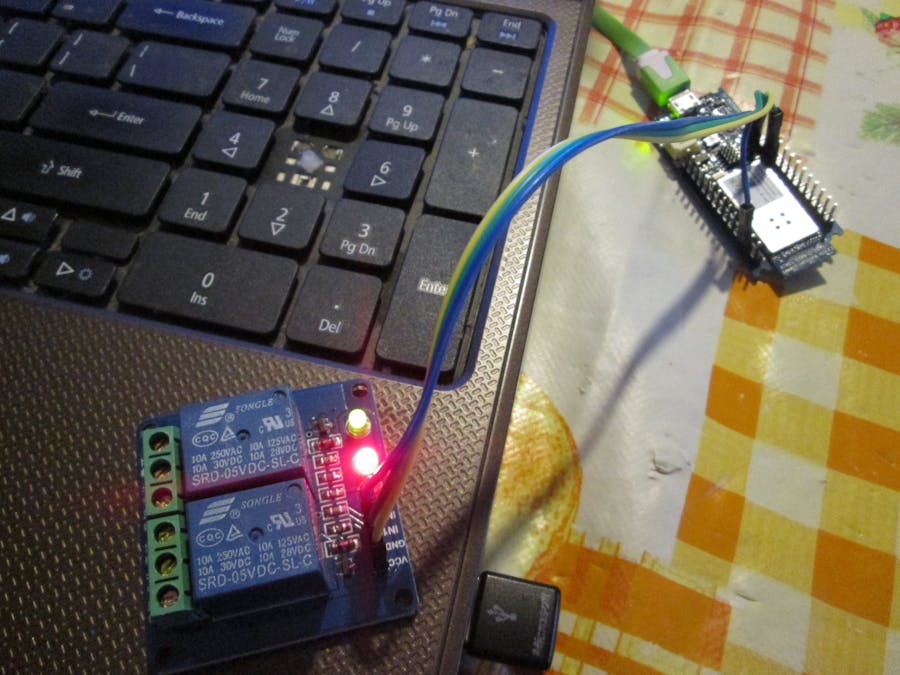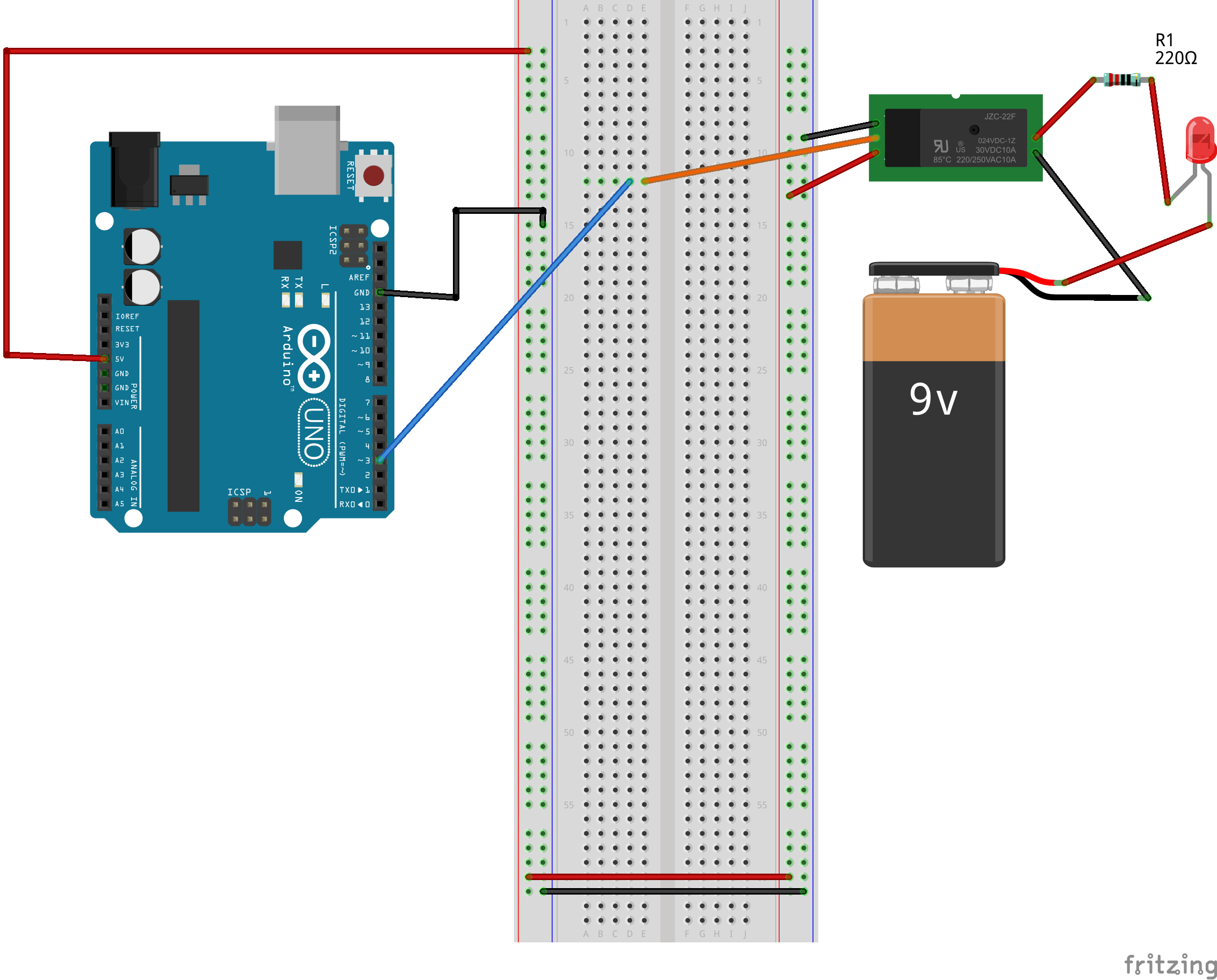Hardware components | ||||||
 |
| × | 1 | |||
| × | 1 | ||||
I won a MKR1000 at the Hackster contest and I got it on my mailbox so I said to myself .. lets keep my promise and do the project for that contest. But first .. I had to play a little with it :)
Here is what I have done: soldered the 2 headers on the MKR1000 kit, installed it in the Arduino IDE and started coding: created an Access Point (AP) and set up a HTTP server that responds to requests sent from a browser or any other HTTP capable client.
I had connected a relay board to the MKR1000 and used the HTTP server to switch one of its channels ON or OFF.
The schematic is really simple, just connect Digital Pin 3 to the IN of the relay board :)
PS: The schematics is showing an UNO not an MKR1000 as the Fritzing don't have the last board on its library.
/**
* DOCS:
* https://github.com/arduino-libraries/WiFi101/
*/
#include <SPI.h>
#include <WiFi101.h>
// Settings & vars for the AP
char ssid[] = "dridif-greenhouse";
char pass[] = "hackme"; // (not supported yet)
int wifi_status = WL_IDLE_STATUS;
// Settings and vars for the HTTP server
int http_port = 81;
WiFiServer http_server(http_port);
WiFiClient http_client;
// Settings and vars for the relays
byte PIN_relay_pump = 3;
byte relay_pump_status = 0;
byte debug_mode = 1;
void wifi_connect_as_ap() {
// Is it IDLE ?
if (wifi_status == WL_IDLE_STATUS) {
// Try to connect
wifi_status = WiFi.beginAP(ssid);
// Wait 10 seconds for connection
delay(4000);
_debug_wifi_status();
// Is it connected?
wifi_connect_as_ap();
}
}
void setup() {
// Setup Serial
while (!Serial);
delay(1000);
Serial.begin(9600);
// Check for the presence of the shield
if (WiFi.status() == WL_NO_SHIELD) {
Serial.println("WiFi shield not present");
while (true); // don't continue
}
// Create the AP
wifi_connect_as_ap();
// Start the HTTP server
http_server.begin();
// Init the relay board
pinMode(PIN_relay_pump, OUTPUT);
digitalWrite(PIN_relay_pump, LOW);
}
byte _is_a_get_request(String txt) {
String tmp = _get_request_path(txt);
if (tmp == "N/A") {
return 0;
}
return 1;
}
/**
* @returns "N/A" if txt is not the right header
*/
String _get_request_path(String txt) {
if (txt.endsWith("HTTP/1.1")) {
txt = txt.substring(0, txt.indexOf("HTTP/1.1"));
if (txt.startsWith("GET")) {
txt = txt.substring(3);
txt.trim();
Serial.println("Requesting " + txt);
return txt;
}
}
return "N/A";
}
String _html_show_on_off_status(int status) {
if (status == 0) {
return "<span style='color:red;'><strong>OFF</strong></span>";
}
return "<span style='color:green;'><strong>ON</strong></span>";
}
void process_http_request(String path) {
if (path == "/") {
http_client.println("Status Relay: "+_html_show_on_off_status(relay_pump_status));
http_client.println("<hr>Actions: <ul>");
http_client.println("<li><a href='/pump_relay_on'>START Pump Relay</a></li>");
http_client.println("<li><a href='/pump_relay_off'>STOP Pump Relay</a></li>");
http_client.println("</ul>");
} else if (path == "/pump_relay_off") {
http_client.println("Pump Relay OFF");
http_client.println("<hr>[<a href='/'>Back to Index</a>]");
digitalWrite(PIN_relay_pump, LOW);
relay_pump_status = 0;
} else if (path == "/pump_relay_on") {
http_client.println("Pump Relay ON");
http_client.println("<hr>[<a href='/'>Back to Index</a>]");
digitalWrite(PIN_relay_pump, HIGH);
relay_pump_status = 1;
} else {
http_client.println("404");
}
}
void process_http_requests() {
// Listen for incoming http_clients
http_client = http_server.available();
byte tmp_request_is_a_get_request = 0;
String tmp_get_request_line = "";
if (http_client) { // if you get a http_client,
Serial.println("New client connected."); // print a message out the serial port
String currentLine = ""; // make a String to hold incoming data from the http_client
while (http_client.connected()) { // loop while the http_client's connected
if (http_client.available()) { // if there's bytes to read from the http_client,
char c = http_client.read(); // read a byte, then
// Serial.write(c); // print it out the serial monitor
if (c == '\n') {
// If the current line is blank, you got two newline characters in a row.
// that's the end of the client HTTP request, so send a response:
if (currentLine.length() == 0) {
// HTTP headers always start with a response code (e.g. HTTP/1.1 200 OK)
// and a content-type so the client knows what's coming, then a blank line:
http_client.println("HTTP/1.1 200 OK");
http_client.println("Content-type:text/html");
http_client.println();
if (tmp_request_is_a_get_request == 1) {
process_http_request(_get_request_path(tmp_get_request_line));
}
break;
}
// We don't really care about other headers .. just the /GET ones
if (_is_a_get_request(currentLine)) {
tmp_request_is_a_get_request = 1;
tmp_get_request_line = currentLine;
}
// Clear the currentLine buffer
currentLine = "";
}
else if (c != '\r') {
// Add to the currentLine buffer
currentLine += c;
}
}
}
// close the connection:
http_client.stop();
Serial.println("Client disconnected.");
}
}
void loop() {
process_http_requests();
}
////////////////////////
// Non-core functions //
////////////////////////
void _debug_wifi_status() {
if (debug_mode == 1) {
// print the SSID of the network you're attached to:
Serial.print("SSID: ");
Serial.println(WiFi.SSID());
// print your WiFi shield's IP address:
IPAddress ip = WiFi.localIP();
Serial.print("IP Address: ");
Serial.println(ip);
// print the received signal strength:
long rssi = WiFi.RSSI();
Serial.print("signal strength (RSSI):");
Serial.print(rssi);
Serial.println(" dBm");
// print where to go in a browser:
Serial.print("To see this page in action, open a browser to http://");
Serial.print(ip);
Serial.print(":");
Serial.print(http_port);
Serial.println();
}
}







Comments
Please log in or sign up to comment.